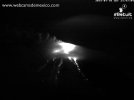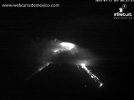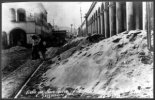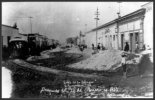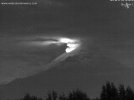Translating from Spanish with the help of google translator … and make more paragraphs in the relate.
The eruption of 1913, a story and a procession
Published: February 5, 2013
There had been 100 years from the eruption of the "volcano Zapotlán" named at sixteenth century but also named "Colima" in the early twentieth century; and recently "Colima Volcano of Fire." The January 20, 1913 began the most intense eruption that produced the volcano during the twentieth century, apparently without causing human deaths. In fact, there had not been deaths associated to CV eruptions at the historical records of Colima State during its volcano activity throughout its history. This is partly because there are few human settlements around the volcano, unlike for example the number of villages located on the slopes of Popocatepetl volcano.
In addition, near the most active volcano in Mexico settlers known natural landmarks and they avoid exposure, even to epiphenomena such as lahars. Country people walking the banks of the volcano has the ear to capture sharp and sudden lahars or avenues "growing" that usually occur during the rainy season, and the stand away well in advance of the stream of water, sand, stones and sticks. However, settling in the bed of streams and canyons surrounding the Colima Volcano of Fire had been deadly, as in the town of Atenquique the October 16, 1955, when 23 people died buried in lahar.
The activity of the Colima Volcano of Fire teaches us that the path and intensity of the winds, their effects from the fall of sand and ash can pose health risks and impacts in productive infrastructure and sectors. To identify these records are useful stories or historical accounts that have some credence, narrating observed and distance themselves from fantasy literature. Therefore is worth reading the following stories that had been collected by the architect Fernando G. Castolo, director of the Municipal Archives and History "John S. Vizcaino Zapotlán el Grande, Jalisco," in whom we thank him his generosity to facilitate images illustrating this document.
According to testimony of the political head of Zapotlán el Grande in 1913, he relates: "The Colima Volcano made its first eruption around 4:30 am and consisted of small explosions of small magnitude. But an underground rumor 11:30 followed by a detonation was heard, rising in space a beautiful cloud of incalculable magnitude, and since then was a series of eruptions continued almost without interruption, it might well be said one, and 1:00 pm began to fall a shower of sand that was taking large and alarming proportions, as at 2:00 pm, thick clouds had invaded the horizon, rain sand was so strong it resembled a storm water, producing deep darkness. Until 8:30 pm calmed down the volcanic rumbling and lightning, and it was noted that the sandstorm decreased. At 10:00 pm the horizon calmed completely and, the moon was seen. The sand was “jalosa” of a thickness of average 8 cm., which buried pastures, wheat, alfalfa, beans and generally all crops that began to be born and grow. The city resembled an immense sandy beach sea or desert ... "(1)
Given the spectacular volcanic activity, the affected society reacted in different ways, one of which was to request divine intervention and protection of its patron saint, although the procession could intensify at that time the ideological conflict between religious and liberals. In this regard, a document from the Zapotlán Parish, transcribed by architect Fernando G. Castolo it is reads as follows:
At Margin.-Rain of Sand of El Colima.
Inside.- On Monday, 20th of this month, since the morning "The Colima" had several visible maximum eruptions seen from this city, and the people who were present could admire a truly extraordinary, grand and imposing spectacle. At one o'clock in the afternoon the sky began to “cloak”; and soon later falling ash. At one-forty minutes, the fine sand produced on leaves little hits like those on May rains in plants.
Darkness. Soon the darkness was entering itself in such a way that at about quarter past two, were submerged in terrifying darkness that made us imagine the memorable evening of Calvary.
Power detonations. The discharges produced in the atmosphere bearing with electricity and heat impacted unusually causing a little sadness that lead to panic. Women and children possessed by fear, feeling no safe in their homes, run for the churches for safety. Men, trying to remain in control, were seen in their faces the deep anguish they felt; and, several gentlemen and ladies gathered at the “curato” (office/room of the priest-nt). They request permission for a procession of Saint Joseph always in trance as they were concerned had been the zapotlenses comfort, the shoulder to cry of these children.
Pastor attitude. He let them see prudence to those honorable people, since
public procession were against the laws, and that liberals, especially in recent days, have been bothering with insults, accusations and taunts to civil authorities and church, they could take the occasion for new excesses in the procession.
In the parish. A few moments later the parish church was filled with people. The spectacle we witnessed was a touching, sublime ... millions of prayers rose from those contrite hearts by misfortune, and the cry of a thousand cries, multiplied by the echo of the sacred vaults filled the grounds of the Sanctuary with the piety of its whole people ... Saint Joseph. It was descended from it’s altar, the venerated image, catastrophic witness, the beloved patron of Zapotlán has taken advantage to preserve the Christian faith among us. Lowering the beloved image of Saint Joseph to approach their children from the resounding cry, the furtive tears of others, the violent beating of all hearts were irresistible sweet prayer that Father came to this city that worships both.
The procession. Snatched do not know by which hands or rather by the strength of the ardent faith of so many souls, accompanied by more than ten thousand souls, left the sacred image calming their desired presence the longing of the faithful, that only its always beneficial expected protection remedy was in great need.
Back to the Church. After three hours, the Holy Image returned to it’s temple, going to his knees many of the faithful, full of confidence persevered in prayer until the rain stopped the sand. Eight in the evening was when the falling sand stopped, leaving a layer of eight or seven centimeters thick on the pavement of the streets and on the roofs of houses.
The next day (21). It dawned Ciudad Guzman, as covered by a shroud lead dye that was sadness and mourning buildings, squares and gardens. Fears. It was feared that the water vapors that generally accompany volcanic eruptions, were resolved in more severe rain and do the weight of the sand that covered the ceilings; but God intended them to be very slight rains caused no harm. Some people said It could come any stream of deadly gases, most did not happen. Exodus of Families. Many families left the night of 20 carriages that Mexican railway made available to the public. Days later leaved many others, and those who emigrated Monday night, had returned. Sand and ash spewing from "The Colima" reached the cities of Zacatecas, Aguascalientes and San Luis Potosi. We received a telegram from Arandas in which told us about the great alarm from the rain sand. San Juan de los Lagos let us know that all night many people, alarmed by electrical explosions and the falling ash and sand, did penance and prayer in the streets and temples of the city ... "(2)
In 1913, the population of Colima state were an spectator of the eruption, while in Jalisco state were shocked and lived moments of anguish. For reasons like this, the Colima Volcano of Fire is differentially perceived as a threat to the communities in the area; even between Colima and Jalisco there are changes the perception, for the effects and impacts of the eruptive activity they were different in each entity.
Overall the volcano is a threat because it represents risks for vulnerable society that lives of those who had been most impacted, such as agriculture and livestock production sectors. The risk of death by volcanic eruption has been reduced to reduce exposure and improve communication with communities and accelerate the movement of society where there is an emergency situation. A clear example in 1913 was the use of railway wagons in the service of the public to evacuate the affected people. However, risks such as loss of crops and livestock to be reduced with more administrative strategies.
The land around the Volcano de Fuego de Colima is very fertile, partly because the minerals that receives the ashes, but one should learn to live with these natural conditions to turn a threat into a benefit for the communities. Historical eruptions show moments of crisis, but had been decades of boom in the natural environment of Colima Volcano of Fire, though everyone tells how they fared the show.
References:
Castolo, Fernando G. (Comp.) 2012 Zapotlán, San Jose and Colima Volcano (texts on the eruption of January 20, 1913) General and Municipal Archives "John S. Vizcaino Zapotlán el Grande, Jalisco" Ciudad Guzman.
* Bachelor of Arts and Journalism, History teacher and doctoral student in anthropology at the CIESAS DF. Colima member of the Society for Historical Studies. Blog: _https://raypadilla.wordpress.com/

